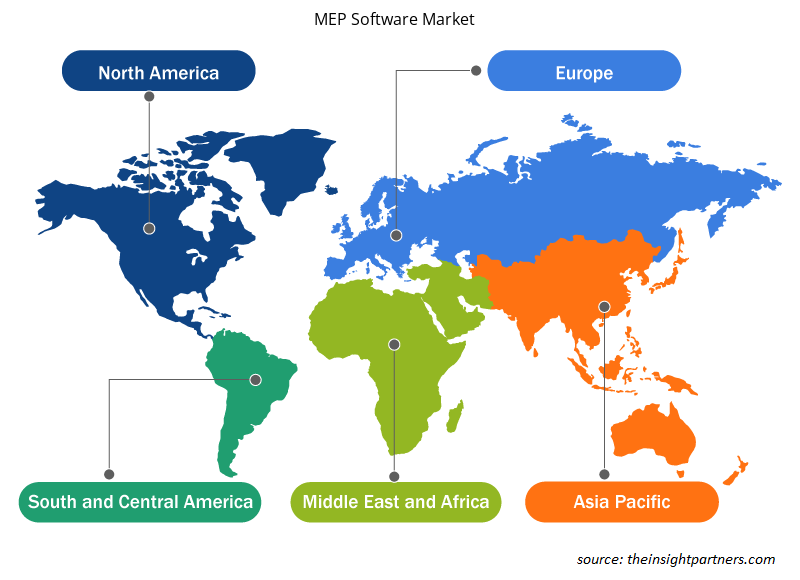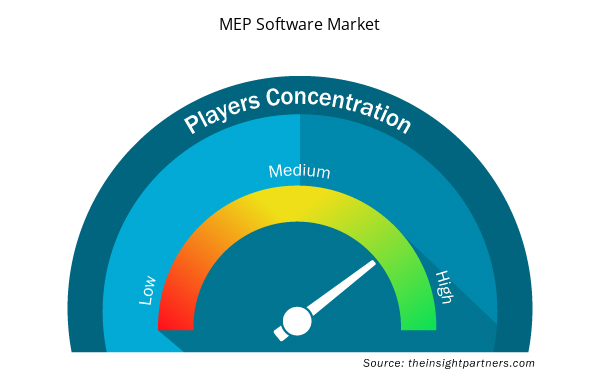The MEP Software Market is expected to register a CAGR of 10.6% from 2025 to 2031, with a market size expanding from US$ XX million in 2024 to US$ XX Million by 2031.
The MEP Software Market report covers analysis By Deployment (Cloud-Based, On-Premise); Application (Mechanical Industry, Manufacturing, Constructing, Media Industry, Other) , and Geography (North America, Europe, Asia Pacific, and South and Central America)
Purpose of the Report
The report MEP Software Market by The Insight Partners aims to describe the present landscape and future growth, top driving factors, challenges, and opportunities. This will provide insights to various business stakeholders, such as:
- Technology Providers/Manufacturers: To understand the evolving market dynamics and know the potential growth opportunities, enabling them to make informed strategic decisions.
- Investors: To conduct a comprehensive trend analysis regarding the market growth rate, market financial projections, and opportunities that exist across the value chain.
- Regulatory bodies: To regulate policies and police activities in the market with the aim of minimizing abuse, preserving investor trust and confidence, and upholding the integrity and stability of the market.
MEP Software Market Segmentation
Deployment
- Cloud-Based
- On-Premise
Application
- Mechanical Industry
- Manufacturing
- Constructing
- Media Industry
- Other
Customize This Report To Suit Your Requirement
You will get customization on any report - free of charge - including parts of this report, or country-level analysis, Excel Data pack, as well as avail great offers and discounts for start-ups & universities
MEP Software Market: Strategic Insights

- Get Top Key Market Trends of this report.This FREE sample will include data analysis, ranging from market trends to estimates and forecasts.
MEP Software Market Growth Drivers
- Increased BIM Adoption: The usage of BIM in the construction and architecture industry is highly pushing the growth of the MEP software market. This practice integrates mechanical, electrical, and plumbing designs into one model with better coordination and thus good visualization of the project, followed by collaboration among parties involved, thereby efficient execution of the project.
- Energy Efficiency and Sustainability Focus: That momentum, created by the mounting demand for energy efficiency and sustainability, is being met by adjusting the construction industry toward greener, more sustainable practices. Instead of developing unsafe MEP software, which might be required during construction, designs, and solutions should be embracing energy-efficient solutions. This software helps the engineer optimize and possibly analyze the environment concerning impacts, ensuring sustainability compliance in both engineering and regulation sectors in terms of carbon footprint reduction.
- Adoption of BIM and Digitalizationin Construction: Building Information Modeling and digitalization of the construction sector have been major growth drivers in the MEP software market. BIM can create a digital twin for any building; thereby, all stakeholders can interact more effectively and make data-driven decisions throughout the entire project lifecycle. MEP software integrates well with BIM systems to provide accurate 3D models, real-time data, and simulations of mechanical, electrical, and plumbing systems. This ensures that building systems are designed, coordinated, and optimized properly, which reduces the risk of costly errors and delays. As digitalization continues to evolve in the construction industry, the role of MEP software is very significant in enhancing efficiency, minimizing costs, and ensuring quality in construction works, which has led to market growth.
MEP Software Market Future Trends
- Integration of MEP Software with Building Information Modeling: BIM technologies are going to play an increasingly key role in MEP software going forward. Such integration will bring about improvements in cooperation among architects, engineers, and contractors who will collaborate using a single system in designing and managing building systems. The updates will be done in real-time, there will be enhanced visualization of mechanical, electrical, and plumbing systems; and then the conflict detection will be made superior so that improved project workflows translate into less construction delay.
- Acceptance of Cloud-Based MEP Solutions: The largest driver in the MEP software market will be cloud technology because it allows for remote access, cooperation, and data exchange across project teams. This would thus mean that while working on MEP projects, stakeholders would have greater possibilities to collaborate in real-time, make changes easier, and have access to different kinds of information from around the globe. This is likely to enhance project management efficiency by not requiring an on-premises infrastructure as well as making MEP software accessible and affordable to firms regardless of their size.
- Focus on Sustainability and Energy Efficiency: With sustainability increasing its grip on construction and building management, the sophisticated developments of MEP software would likely include high-end energy modeling, sustainability analysis, and green building standards compliance in the future. MEP solutions would have tools to guide engineers in energy-efficient system designs and better resource utilization. That in itself is going to lay down good support for regulatory compliance and serve the sustainability imperatives of companies that attract clients who prioritize such eco-friendly practices.
MEP Software Market Opportunities
- BIM Integration: MEP Software is well integrated with Building Information Modeling (BIM), which offers a sizeable opportunity concerning improving the efficiency of the design process and interoperability. As construction gets more complex, it will be possible to view better coordination and visualization of the detailed 3D models of type, including mechanical, electrical, and plumbing systems. Companies can develop MEP software that would cooperate with different BIM platforms. This helps allow for an instantaneous real-time update, clash detection, and efficient workflow that saves additional time to deliver the project and decreases costs.
- Cloud Solutions: Cloud solutions are reshaping the future of how MEP professionals will operate their projects and collaborate with teams. Companies will be able to make MEP software more accessible, facilitate real-time collaboration, and minimize IT overhead for the users by providing cloud-based MEP software. This opens up more opportunities for targeting small firms or companies found in distant locations that would not afford the traditional client-server software on-premises. Furthermore, cloud-based solutions can be more easily updated, and integrated with other construction management tools and, therefore, offer easier operations.
- Focus on Energy Efficiency and Sustainability: As such, energy efficiency becomes one of the top elements of construction and building management. Hence, the MEP software would become of prime importance in optimizing energy efficiency. Currently, there is a high demand for software designed to help in the creation of energy-efficient HVAC systems, electrical layouts, and plumbing designs that must adhere to the regulations of green buildings. Companies can capitalize on this trend by developing MEP software that contains advanced simulation tools, energy modeling, and compliance tracking. This will enable them to provide sustainable designs that are not only compliant with the regulations but also environmentally conscious clients to engineering firms and contractors.
MEP Software Market Regional Insights
The regional trends and factors influencing the MEP Software Market throughout the forecast period have been thoroughly explained by the analysts at Insight Partners. This section also discusses MEP Software Market segments and geography across North America, Europe, Asia Pacific, Middle East and Africa, and South and Central America.

- Get the Regional Specific Data for MEP Software Market
MEP Software Market Report Scope
| Report Attribute | Details |
|---|---|
| Market size in 2024 | US$ XX million |
| Market Size by 2031 | US$ XX Million |
| Global CAGR (2025 - 2031) | 10.6% |
| Historical Data | 2021-2023 |
| Forecast period | 2025-2031 |
| Segments Covered |
By Deployment
|
| Regions and Countries Covered | North America
|
| Market leaders and key company profiles |
MEP Software Market Players Density: Understanding Its Impact on Business Dynamics
The MEP Software Market market is growing rapidly, driven by increasing end-user demand due to factors such as evolving consumer preferences, technological advancements, and greater awareness of the product's benefits. As demand rises, businesses are expanding their offerings, innovating to meet consumer needs, and capitalizing on emerging trends, which further fuels market growth.
Market players density refers to the distribution of firms or companies operating within a particular market or industry. It indicates how many competitors (market players) are present in a given market space relative to its size or total market value.
Major Companies operating in the MEP Software Market are:
- MagiCAD Group
- Trimble MEP
- CTC Software
- GOMO MEP
- AutoSPRINK
Disclaimer: The companies listed above are not ranked in any particular order.

- Get the MEP Software Market top key players overview
Key Selling Points
- Comprehensive Coverage: The report comprehensively covers the analysis of products, services, types, and end users of the MEP Software Market, providing a holistic landscape.
- Expert Analysis: The report is compiled based on the in-depth understanding of industry experts and analysts.
- Up-to-date Information: The report assures business relevance due to its coverage of recent information and data trends.
- Customization Options: This report can be customized to cater to specific client requirements and suit the business strategies aptly.
The research report on the MEP Software Market can, therefore, help spearhead the trail of decoding and understanding the industry scenario and growth prospects. Although there can be a few valid concerns, the overall benefits of this report tend to outweigh the disadvantages.
- Historical Analysis (2 Years), Base Year, Forecast (7 Years) with CAGR
- PEST and SWOT Analysis
- Market Size Value / Volume - Global, Regional, Country
- Industry and Competitive Landscape
- Excel Dataset



Report Coverage
Revenue forecast, Company Analysis, Industry landscape, Growth factors, and Trends

Segment Covered
This text is related
to segments covered.

Regional Scope
North America, Europe, Asia Pacific, Middle East & Africa, South & Central America

Country Scope
This text is related
to country scope.
Frequently Asked Questions
Key companies in this market are: MagiCAD Group, Trimble MEP, CTC Software, GOMO MEP, AutoSPRINK, Vectorworks Inc, GRAPHISOFT SE, Autodesk Inc, MEPSOFTWARE
The report can be delivered in PDF/PPT format; we can also share excel dataset based on the request.
Some of the customization options available based on request are additional 3-5 company profiles and country-specific analysis of 3-5 countries of your choice. Customizations are to be requested/discussed before making final order confirmation, as our team would review the same and check the feasibility.
The MEP Software Market is expected to register a CAGR of 10.6% from 2023-2031.
Key future trends in this market are - BIM integration with MEP software for efficient collaboration, real-time cloud-based MEP solutions for project management, advanced energy modeling and sustainable MEP practices.
The primary factors influencing growth of the MEP Software Market are Increasing Complexity of Building Systems, Rising Demand for Energy Efficiency, and Advancements in Building Information Modeling (BIM)
Trends and growth analysis reports related to Technology, Media and Telecommunications : READ MORE..
1. MagiCAD Group
2. Trimble MEP
3. CTC Software
4. GOMO MEP
5. AutoSPRINK
6. VectorworksInc
7. GRAPHISOFT SE
8. Autodesk Inc
9. MEPSOFTWARE
10. Exactal Group Limited

 Get Free Sample For
Get Free Sample For